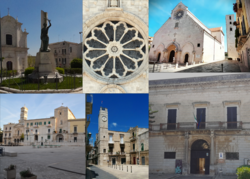Ruvo di Puglia
| |
|---|---|
| City of Ruvo of Apulia | |
 Some of the Ruvo's monuments | |
| Motto(s): Ruvo died to relive, like the Phoenix of Helipolis, from its ashes[1] | |
| Coordinates: 41°07′N 16°29′E / 41.117°N 16.483°E | |
| Country | Italy |
| Region | Apulia |
| Metropolitan city | Bari (BA) |
| Frazioni | Calendano |
| Government | |
| • Mayor | Pasquale Roberto Chieco (Democratic Party) |
| Area | |
| • Total | 221 km2 (85 sq mi) |
| Elevation | 240 m (790 ft) |
| Population (2022)[3] | |
| • Total | 25 341 |
| Demonym | Ruvesi (Italian) Ruvestines |
| Time zone | UTC+1 (CET) |
| • Summer (DST) | UTC+2 (CEST) |
| Postal code | 70037 |
| Dialing code | 080 |
| Patron saint | Saint Blaise |
| Saint day | February 3 |
| Website | Official Municipality Website of Ruvo |
Ruvo di Puglia (Italian: [ˈruːvo di ˈpuʎʎa]; Ruvestine: Rìuve [ˈriːuvə]) is a city and comune (municipality) of 25,457 inhabitants (as of 2017)[4] in the Metropolitan City of Bari in Apulia.
It is a art city of Apulia,[5][6] and a Apulian tourist destination.[7] Part of the Alta Murgia national park, which contains its own operational office, it is home to the Jatta National Archaeological Museum, known for its many Hellenistic period pieces[8] including the Vase of Talos, a community symbol.[9] It is also home to the Municipal Art Gallery of Contemporary Art,[10] named after Domenico Cantatore, a ruvestine expressionist and cubist painter. His artwork is kept there. Additionally, the city houses the Book Museum at Palazzo Caputi,[11] where volumes of medieval and renaissance poetry originates from. It is also the third largest municipality in the Metropolitan City of Bari. It is an olive oil and wine producer city,[12] and an important industrial research center of the Apulian region.[13]
- ^ Fenicia, Salvatore (1857). Monografia di Ruvo di Magna Grecia. Neaples: Salvatore Piscopo.
- ^ "Superficie di Comuni Province e Regioni italiane al 9 ottobre 2011". Italian National Institute of Statistics. Retrieved 16 March 2019.
- ^ Population from ISTAT
- ^ "Timelines Explorer - Data Commons". datacommons.org. Retrieved 2023-07-14.
- ^ "Ruvo di Puglia è 'Città d'arte'" [Ruvo di Puglia is 'City of art']. ANSA (in Italian). 2 March 2018.
- ^ "Ruvo di Puglia diventa Città d'arte: il riconoscimento dalla Regione" [Ruvo di Puglia became City of Art: the recognition by the region]. La Repubblica (in Italian). 2 March 2018.
- ^ "Ruvo di Puglia, solo giudizi positivi da parte dei turisti stranieri" [Ruvo di Puglia, only positive reviews from foreign tourists]. Puglia.it (in Italian). 22 October 2018.
- ^ Di Palo, Francesco. Museo Archeologico Jatta [Jatta Archeological Museum] (in Italian). 1993.
- ^ "Quel vaso di Talos che dà lustro a Ruvo" [That vase of Talos that brings prestige to Ruvo]. La Repubblica (in Italian). 10 June 2001.
- ^ Mattioli, Massimo (2 March 2015). "Un museo per Domenico Cantatore. Inaugurata a Ruvo di Puglia, città natale dell'artista, la Pinacoteca Comunale di arte contemporanea: ecco le immagini" [A museum for Domenico Cantatore. Inaugurated in Ruvo di Puglia, the artist's birthplace, the Municipal Art Gallery of Contemporary Art: here are the images]. Artibune (in Italian).
- ^ "Museo del libro e Casa della cultura" [Museum of Book and House of Culture.]. CARTApulia (in Italian).
- ^ Copertino, Paola (19 November 2020). "La Cantina di Ruvo di Puglia e i vini Crifo, una storia di successo ed evoluzione. A tu per tu con il Presidente Dr. Sebastiano Marinelli" [The Wine Cellar of Ruvo di Puglia and Crifo wines, a story of success and evolution. Face to face with the President Dr. Sebastiano Marinelli]. Bariseranews.it (in Italian).
- ^ "Il presidente Conte celebra l'eccellenza della Itel" [The President Giuseppe Conte celebrates the excellence of Itel]. itelte.it (in Italian). 13 April 2019.




